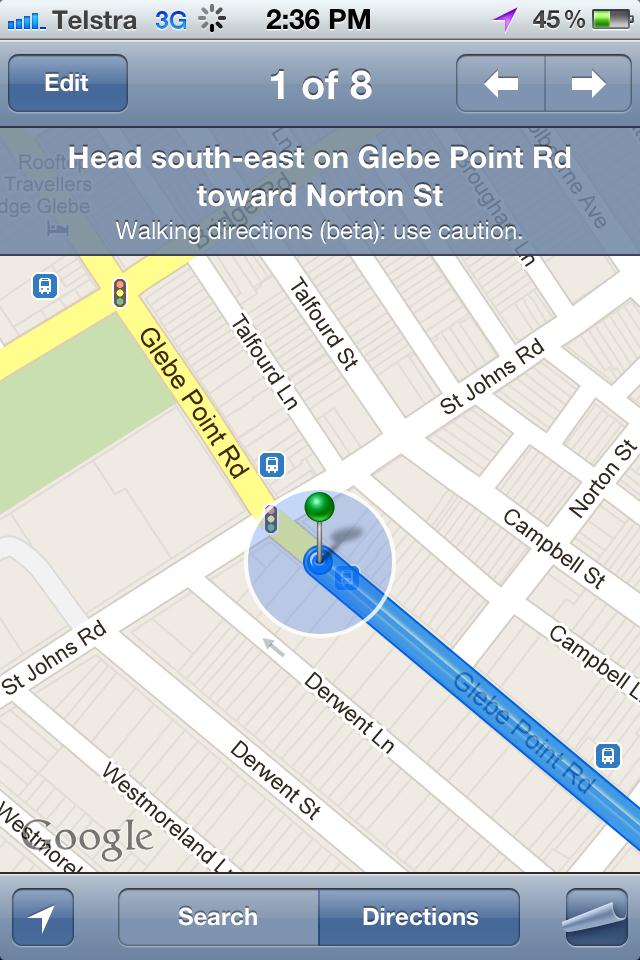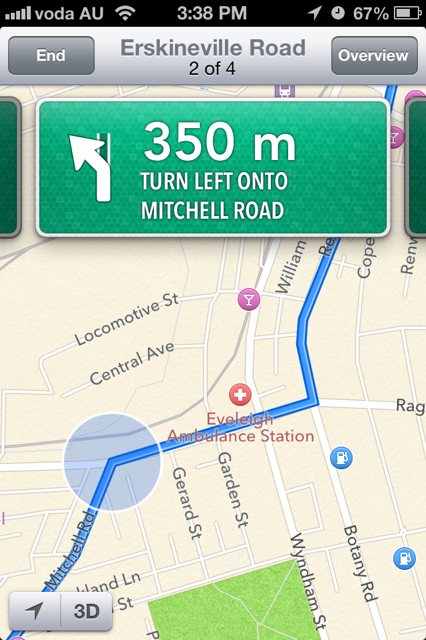General
To echo what many other critics have expressed, Maps shows some inaccuracy in the mapping content that it provides. The level of detail that the app provides is minimal at this stage and as many have reported, some landmarks are misrepresented.
While inaccurate mapping content makes it difficult for anyone, for a person who is blind or vision impaired, the inaccurate information would be hard to verify. As an Apple app however, the inbuilt screen reader VoiceOver works with most of the features in Maps and instructions on how to activate a button or feature are announced.


Directions
The turn-by-turn voice directions feature delivers audible navigational instructions, in addition to text instructions on the screen. While it has not yet been made available in Australia, VoiceOver works well with the text instructions on the screen.
The way the navigational instructions work with VoiceOver is considerably more seamless than the way VoiceOver works with directions on Google Maps. As a comparison, when you use VoiceOver to announce directions in Google Maps, you have to navigate to the ’next’ button to view the next set of instructions and then navigate back down to the instructions to hear them with VoiceOver. In Apple Maps, you can hear directions through VoiceOver in one step, then swipe up or down with one finger to access the next set of directions or go back to the previous set.
The tracking function
Apple has introduced a tracking function in Maps which can be used in two ways. The first is to use this button to mark your current location on the map. The second is to use it as 'onward heading', a compass-like function that follows you as you walk or follow the route suggested by Maps.
When you set tracking as a compass, VoiceOver announces the street or landmark you are approaching. The compass also moves the map around to match which way you're facing.
VoiceOver reads out the street names
When you view a route suggested by Maps, you can also move your finger across the screen to hear VoiceOver announce street names, including orientation. For example, if your finger points to York St on the screen and it spans from North to South, VoiceOver will announce, "York St, North-South road." The feature allows blind or vision impaired users to identify what streets are near their current location.
Integration with Mail, Messages, Twitter and Facebook
Apple Maps has integrated Mail, Messages, Twitter and Facebook. This means you can share your current location (or any location you drop a pin on) via email, messages and social media. Sharing your location on Twitter or Facebook will post a link that will show details of your location on Apple Maps. This share facility introduced by Apple Maps could be useful for blind or vision impaired users to share where they are with friends, even if they are unsure of what their immediate surroundings are.
Accessibility comments
While Apple continues to build up the accuracy of its mapping services, the new features introduced in iOS 6 such as the tracking function, integration with email, messages and social media, and in particular, integration with VoiceOver, show there is considerable potential for the app to become an accessible alternative to Google Maps.
Top of page

